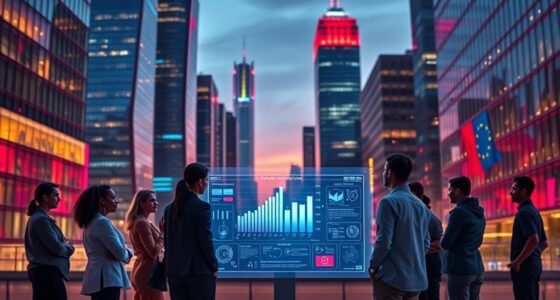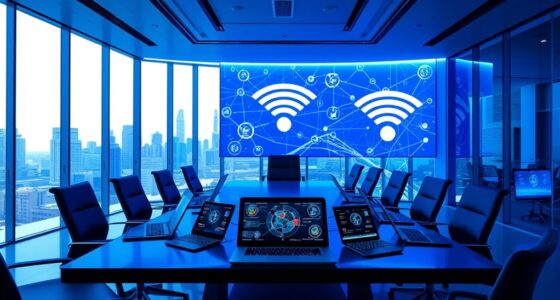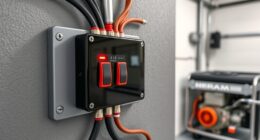By 2025, AI-powered robotics are revolutionizing industries by making machines smarter, more adaptable, and safer to work alongside humans. You’ll see robots that learn from their environment, optimize workflows, and handle complex tasks like predictive maintenance and personalized production. These innovations boost efficiency, reduce errors, and improve safety across manufacturing, logistics, and automation sectors. Stay with us, and you’ll uncover how these advancements are shaping the future of industrial automation.
Key Takeaways
- By 2025, AI-powered robots will dominate manufacturing, logistics, and warehousing with increased autonomy and real-time decision-making.
- Integration of adaptive learning allows robots to optimize workflows and reduce errors in diverse industrial environments.
- Human-robot collaboration will become standard, enhancing safety and enabling robots to handle complex and dangerous tasks.
- Predictive maintenance driven by AI will minimize downtime and improve equipment reliability across industries.
- Industry 4.0 will see widespread deployment of personalized, flexible robotic systems supporting customized production.

Artificial intelligence is transforming robotics, enabling machines to perform complex tasks with greater autonomy and precision. As you look ahead to 2025, you’ll notice how AI integration is revolutionizing industrial processes by making robots smarter and more adaptable. This shift isn’t just about adding AI components to existing machinery; it’s about rethinking how robots operate within manufacturing, logistics, and other sectors. Robotics automation, powered by AI, allows machines to make real-time decisions, optimize workflows, and handle unpredictable situations without constant human oversight.
AI-driven robotics are revolutionizing industries with smarter, more adaptable machines capable of autonomous decision-making and real-time optimization.
When you consider AI integration in robotics, it becomes clear that these systems are no longer limited to repetitive, pre-programmed actions. Instead, they learn from their environment, improve over time, and adjust their behavior accordingly. This ability to learn is essential for industries aiming to increase efficiency while reducing errors and downtime. For example, in assembly lines, AI-enabled robots can detect defects, adjust their operations on the fly, and collaborate seamlessly with human workers. This synergy boosts productivity and safety, creating a smarter, more responsive work environment.
Robotics automation, driven by AI, also means that tasks once deemed too complex or dangerous for humans are now feasible for machines. Autonomous mobile robots (AMRs) are becoming commonplace in warehouses, maneuvering through crowded spaces, avoiding obstacles, and fetching items with minimal human intervention. This level of independence hinges on sophisticated AI algorithms that process sensor data in real time, enabling robots to adapt to changing conditions instantly. As a result, your supply chain becomes more resilient, flexible, and capable of handling increased demand without sacrificing accuracy.
Moreover, AI-driven robotics is paving the way for more personalized production. In industries like electronics or custom manufacturing, robots can quickly switch between different products or configurations, thanks to AI integration. This agility allows companies to meet individual customer needs without lengthy downtime for reprogramming. Robotics automation also extends to predictive maintenance, where AI analyzes data from machines to forecast failures before they happen, reducing costly outages and keeping production lines running smoothly.
Frequently Asked Questions
What Are the Biggest Challenges in Integrating AI With Robotics?
The biggest challenges you face when integrating AI with robotics include ensuring sensor calibration for accurate data and managing data privacy concerns. You need to fine-tune sensors regularly to keep systems reliable, while also safeguarding sensitive information from breaches. Balancing these technical and ethical issues can be tough, but addressing them is vital for successful AI-robotics integration, enabling safer, more efficient industrial operations.
How Will Ai-Driven Robots Impact Global Manufacturing Jobs?
You’ll see AI-driven robots reshape global manufacturing jobs by replacing repetitive roles, leading to potential job displacement. But, you’ll also need to adapt skills quickly to stay relevant, as automation advances. This technological transformation transforms tasks, requiring workers to upskill and reskill. While some jobs fade, new opportunities arise, demanding dynamic dedication to learning and adapting in an evolving industrial landscape.
What Cybersecurity Risks Are Associated With Industrial AI Robots?
You should be aware that industrial AI robots pose cybersecurity risks like data breaches and unauthorized access. To protect your systems, implement strong data encryption to secure sensitive information and strict access control to limit who can operate or modify the robots. Regular security updates and monitoring are vital to detect vulnerabilities early, ensuring your manufacturing environment remains safe and resilient against cyber threats.
How Do AI and Robotics Ensure Safety in Shared Workspaces?
You might wonder how AI and robotics keep shared workspaces safe. They rely on stringent safety standards and advanced collaborative protocols that detect human presence and adapt in real-time. Sensors and machine learning algorithms monitor environment conditions constantly, preventing accidents before they happen. These systems create a seamless, secure interaction, ensuring humans and robots work side-by-side without risking safety—transforming industrial safety into a future-proof reality.
What Regulatory Hurdles Must Be Overcome for 2025 Rollouts?
You’ll need to navigate regulatory hurdles like safeguarding intellectual property and ensuring adherence to ethical standards. Manufacturers must secure patents and protect proprietary AI algorithms from theft or misuse. Additionally, complying with evolving ethical guidelines is vital to avoid legal issues and public backlash. Staying proactive in addressing these areas helps smooth the 2025 rollout, ensuring your AI and robotic systems meet legal requirements and societal expectations effectively.
Conclusion
As 2025 approaches, imagine a symphony where AI and robotics dance seamlessly, transforming factories into vibrant hubs of innovation. You’ll see automation breathe new life into industries, like a painter adding bold strokes to a blank canvas. The future isn’t distant anymore; it’s knocking on your door, ready to turn the gears of progress. Embrace this dawn where human ingenuity and machine precision intertwine, creating a masterpiece of industrial evolution.










